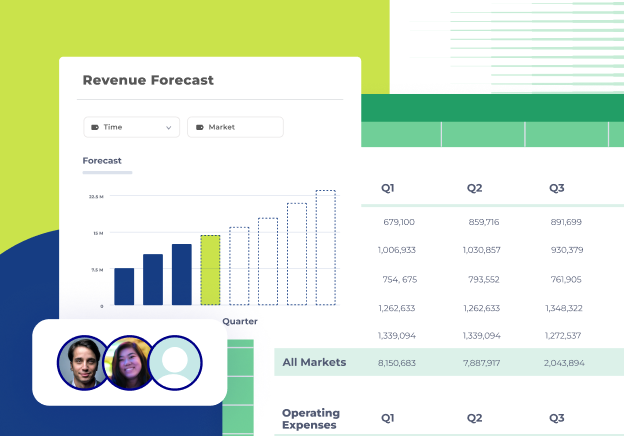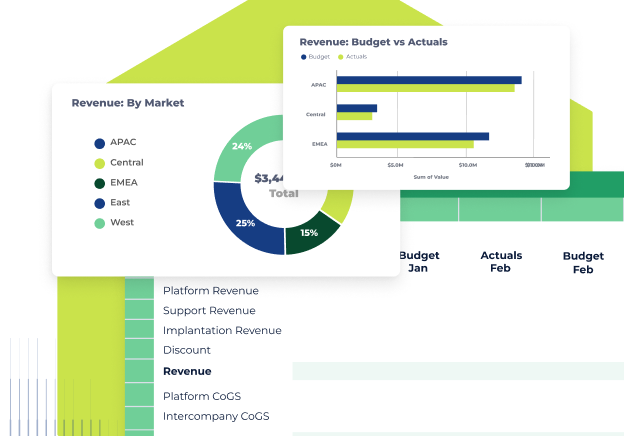What is EBIT (Earnings Before Interest and Taxes)?
EBIT stands for Earnings Before Interest and Taxes. It's a profitability indicator or a measure of a company's earnings potential, representing the pure operating performance of a business before accounting for financing decisions and tax environments.
This metric is particularly useful for investors and analysts because it focuses on core business operations, revealing how efficiently a company generates profits from its primary activities. By excluding interest and tax expenses, EBIT allows stakeholders to evaluate a company’s fundamental earning power without the distortions of capital structure or regional tax policies.
It's simple: The higher it is, the better.
What are interest expenses and tax expenses?
Interest and tax expenses include any interest a company pays and taxes. Some places where interest expenses might occur include:
- Bonds
- Loans
- Convertible debt
- Mortgages
- Lines of credit (e.g., company credit cards)
Companies should keep interest expenses manageable by maintaining a stable interest coverage ratio (i.e., the ratio of EBIT to interest expense). A higher interest coverage ratio means a company can better cover its interest expenses.
Meanwhile, tax expenses might come from:
- Income taxes (sometimes called corporation taxes)
- Sales tax (sometimes called VAT, value-added tax)
- Property taxes
- Excise taxes
- Employment taxes
- Dividend tax
- State income taxes
- Federal income taxes
- Local taxes
The income tax expense is one of the largest, and it's important to factor it into your headcount planning.
EBIT formula and example calculation
The EBIT calculation is straightforward: Subtract all expenses (except interest expenses and tax expenses) from your company's net income. The resulting difference is your EBIT.
The EBIT formula is:
EBIT = Revenue - Operating expenses (except any interest expense or tax expense)
Or, put another way:
EBIT = Net income + Interest + Taxes
Another EBIT calculation you might have seen is:
EBIT = Revenue - COGS (Cost of goods sold) - Operating expenses
But as you'll see, this is the formula for operating income.
EBIT calculation example
It's easy to calculate EBIT if you have access to your net earnings and interest and tax expenses. Here's an example:
Net earnings: $1,000,000
Interest expenses: $50,000
Taxes: $450,000
EBIT = Net earnings + Interest + Taxes
EBIT = $1,000,000 + $50,000 + $450,000
EBIT = $1,500,000
Why is EBIT important for finance teams and investors?
Investors and other external stakeholders often use EBIT (or its close cousin, EBITDA) to assess a company's profitability. While EBIT isn't a perfect metric in isolation, it's helpful in context, especially when comparing companies in the same industry.
To get a holistic view of a company's core business operations, investors and other stakeholders also look at a company's financial statements (the income statement, the balance sheet, and the cash flow statement). They'll also look at that profit and income sliced in a few different ways: a company's gross profit, operating profit, and operating expenses.
A few financial ratios, like return on capital employed (ROCE), use EBIT in their calculations. So, it's good to have your company's EBIT on hand.
What's the difference between EBIT vs. EBITDA?
EBIT is earnings before interest and taxes. EBITDA is EBIT, but before depreciation and amortization expenses. Because of this, EBITDA is generally considered a more accurate depiction of a company's operating income.
Like EBIT, EBITDA excludes the effect of capital expenditure, capital structure, and tax jurisdiction. So while EBIT includes some non-cash expenses, EBITDA is only earnings minus cash expenses.
Use in financial ratios
EBIT and EBITDA get used in different financial ratios. Generally, you'll use EBIT more often.
Financial ratio calculations that include EBIT include EBIT margin, the interest coverage ratio, the fixed interest coverage ratio, the fixed charge coverage ratio, the times interest earned ratio, and the financial leverage ratio.
The only common financial ratios that include EBITDA are the earning margin and the EBITDA multiple. (Which is certainly an important ratio!)
Using EBIT or EBITDA in financial ratios
EBIT and EBITDA are used in different financial ratios. Generally, you'll use EBIT more often. Financial ratio calculations that include EBIT include EBIT margin, the interest coverage ratio, the fixed interest coverage ratio, the fixed charge coverage ratio, the times interest earned ratio, and the financial leverage ratio.
The only common financial ratios that include EBITDA are the earning margin and the EBITDA multiple.
When to report EBIT vs. EBITDA
The best way to decide which to report is to show whichever is higher. If a company has more fixed assets, its depreciation and amortization expenses will likely be higher. So it'll probably want to report EBIT.
However, a company with few fixed assets will be more likely to report EBITDA. With that in mind, savvy investors will ask for both and compare the two. (Or they'll ask to see the company's income statement.)
Let's look at an example of a sample company's income and cash flow statements.
Company A's income statement:
| Income statement |
| Sales revenue |
$1,700,000 |
| Cost of goods sold (COGS) |
$200,000 |
| Operating expenses (OpEx) |
$100,000 |
| Interest expense |
$50,000 |
| Tax expense |
$150,000 |
| Net income |
$1,200,000 |
Company A's cash flow statement:
| Cash flow statement |
| Net income |
$1,200,000 |
| Less: depreciation and amortization |
$120,000 |
| Less: changes in working capital |
$80,000 |
| Cash from operations |
$1,000,000 |
This company has a relatively low level of depreciation and amortization compared to its net income—only 10%.
But let's calculate EBIT and EBITDA for this company.
EBIT = Sales revenue - COGS - OpEx
EBIT = $1,700,000 - $200,000 - $100,000
EBIT = $1,400,000
And now EBITDA:
EBITDA = EBIT + Depreciation and amortization
EBITDA = $1,400,000 + $120,000
EBITDA = $1,520,000
Since EBITDA is higher for this company, they might prefer to highlight it as a performance metric.
However, since EBITDA isn't that much higher, there's a case for using both. Since D&A are so low, providing both numbers paints a rosier picture than either in isolation.
Why it’s important to calculate EBIT
EBIT plays a role in multiple aspects of financial analysis and business decision-making.
EBIT provides investors with a standardized way to evaluate companies across different industries and tax jurisdictions. For management teams, it helps track operational performance and make strategic decisions about resource allocation.
In financial planning, companies rely on EBIT to evaluate business unit performance, set meaningful performance targets and benchmarks, and make informed decisions about expansion or consolidation strategies. EBIT is also invaluable for investment analysis, allowing companies to effectively compare potential acquisition targets, assess investment opportunities across different markets, and determine accurate company valuations.
From an operational perspective, EBIT helps organizations measure management effectiveness, identify operational inefficiencies, and track year-over-year performance improvements. Additionally, EBIT serves as a foundation for other financial metrics and ratios, such as EBIT margin and interest coverage ratio—which provide further insights into a company’s financial health and operational efficiency.
Advantages and disadvantages of using EBIT
EBIT is a powerful financial metric, but like any analytical tool, it has strengths and limitations. Understanding these trade-offs helps finance teams and stakeholders use EBIT effectively in their analysis and decision-making processes.
Advantages:
- Enables clear company comparisons by removing the impact of different tax rates and debt structures
- Provides insights into operational efficiency and core business performance
- Helps evaluate management effectiveness in generating profits from available resources
- Simplifies cross-border analysis by eliminating varying international tax rates
- Serves as a reliable indicator of a company’s ability to service debt
Disadvantages:
- Overlooks capital structure implications, which can mask underlying financial risks
- Doesn’t account for depreciation differences between companies
- May not reflect true operational costs in capital-intensive industries
- Can be manipulated through accounting choices and timing of expenses
- Doesn’t consider working capital requirements
EBIT's biggest limitation is that it excludes the cost of servicing debt. This means a company can use EBIT to give a misleading impression of its financial resilience. That could cause stock prices to rise or entice investors to make a riskier investment than they would otherwise.
That's not to say you should never use EBIT. Nor that you should never trust it. But you should be aware that a highly leveraged company can report the same EBIT as a company with minimal debt. The company with less debt is the less risky operation, but EBIT doesn't clue you into that. So always dig a little deeper.

What's the difference between EBIT vs. operating income?
EBIT refers to the business’s earnings earned during the period without considering the period's interest and tax expense.
But operating income (or operating profit) refers to the income earned by a business from its principal revenue-generating activities. It does not consider non-operating income and non-operating expenses.
So while EBIT excludes interest and taxes, operating income excludes non-operating income and expenses (like interest and taxes).
How to calculate operating profit
The operating profit/operating income calculation often looks like the EBIT calculation:
Operating income = Gross income - Operating expenses
As you know, gross income is just revenue minus COGS (cost of goods sold). So, we can turn the formula into:
Operating income = Revenue - COGS - Operating expenses
While the EBIT formula looks like:
EBIT = Revenue - Operating expenses
The major difference between EBIT and operating income is that EBIT includes COGS. So, you could also calculate EBIT like this:
EBIT = Operating income + COGS
This also means that EBIT can equal operating income in rare cases where COGS is zero.
Recognition by GAAP
EBIT is not recognized as a GAAP (generally accepted accounting principles) measurement, but operating income is. While EBIT still has a place, it's not used in government audits, for example. It also means you should never accept a company's EBIT in isolation. Always consider EBIT in the context of other metrics, like:
- Operating income (insight into core business profitability)
- Gross margin (overall efficiency in production and service delivery)
- Net profit margin (overall profitability after all expenses)
- Return on assets (how efficiently a company uses its assets)
- Return on equity (measures profitability relative to shareholder investments)
- Debt-to-EBIT ratio (helps assess a company’s debt burden relative to its earnings
Usage
While EBIT is a profitability indicator, operating income is more concerned with raw numbers.
You wouldn't use EBIT to determine how much of your revenue you can convert into profit. You'd use operating income for that.
Likewise, you wouldn't use operating income to show the potential for profitability. You'd use EBIT.
EBIT vs. net income
The difference between EBIT vs. net income comes down to earnings vs. EBIT. As you know, EBIT is earnings before interest and taxes.
Net income is analogous to earnings. So the difference between EBIT vs. net income is that EBIT is net income with interest and taxes added back in.
EBIT vs. EBIT margin
The EBIT margin, also known as the operating margin, is a financial ratio that measures profitability without considering the effects of interest and taxes.
It's easy to calculate: divide EBIT by sales or net earnings.
A company’s operating margin tells you how much profit it makes after subtracting operating costs.
It measures the company's profit after paying for production costs such as wages and raw materials.
These costs vary over time—they’re not fixed costs. So, the operating margin fluctuates accordingly. However, the operating margin doesn’t consider deductions for interest payments or taxes, making it a useful metric for evaluating a company's core profitability before financial and tax obligations are considered.
The formula for operating margin is:
EBIT margin = Operating income ÷ Total revenue
EBIT margin calculation example (%)
Say a company's operating profit is $2,000,000 but its total revenue is $10,000,000.
If we plug that into the EBIT margin formula, we get:
EBIT margin = $2M ÷ $10M = 20%.
Whether or not this is a good number to shoot for depends on the industry.
How to interpret EBIT margin
Generally, a higher EBIT margin is considered better than a lower one.
The average total market operating margin is 13.13%, but a “good” operating margin varies across industries and company types as with gross profit margin. Here are some examples:
- Financial services — 17.99%
- Publishing and newspapers — 8.43%
- Software (entertainment) — 33.55%
NYU Stern School of Business has collated data across multiple industries for average operating margins. Check their full list to find the industry closest to yours, to help you benchmark yours.
EBIT vs. operating profit
While often used interchangeably, EBIT and operating profit can show different results in real-world applications. Operating profit strictly focuses on earnings from core business activities, excluding any non-operating income or expenses.
EBIT, however, captures all income and expenses before interest and taxes, including non-operating items like investment income or asset sale gains. This distinction becomes crucial when evaluating companies with significant operating activities or diverse revenue streams.
For example, a manufacturing company might have an operating profit of $1 million from its core production business, but an EBIT of $1.2 million when including gains from equipment sales and investment income. Understanding this difference helps stakeholders better evaluate true operational performance versus overall earnings potential.
EBIT vs. revenue
While revenue represents the total income generated from all business activities before any deductions, EBIT shows what remains after subtracting operating costs but before interests and taxes. This fundamental difference makes each metric valuable for different purposes.
Revenue indicates market reach and sales effectiveness, but EBIT reveals how efficiently a company converts those sales into earnings.
A company might show impressive revenue growth while struggling with profitability—imagine a tech startup with $10 million in revenue but an EBIT of -$2 million due to high development and marketing costs. Comparing EBIT to revenue (the EBIT margin) helps stakeholders understand how effectively a company manages its costs relative to its income.
EBIT vs. gross profit
Gross profit measures revenue minus direct costs of goods sold (COGS), while EBIT goes further by also subtracting operating expenses like salaries, rent, and marketing costs. This makes EBIT a more comprehensive measure of operational efficiency. A healthy gross profit might mask operational inefficiencies that become apparent in the EBIT figure.
Consider a retail company with $5 million in revenue and $3 million in COGS, yielding a gross profit of $2 million. After deducting $1.5 million in operating expenses, the EBIT becomes $500,000. This significant difference between gross profit and EBIT highlights the impact of operating expenses on overall profitability, making both metrics essential for different aspects of financial analysis.
Streamline your EBIT calculations
You now know how to use EBIT to determine a company's financial health. You also know the difference between EBIT vs. EBITDA and other metrics.
However, there's more than just calculating EBIT. After all, you might find it difficult if your numbers aren't always up-to-date. And that's where Cube can help. Cube connects to all your source systems and to your spreadsheets.
With Cube, it takes barely two minutes to pull data directly from your general ledger into your Excel model, calculate EBIT, and then push that data to Google Sheets to share with stakeholders.
Interested? Book your free demo here.



.png)









.png)

.png)


.png)
.png)
.png)